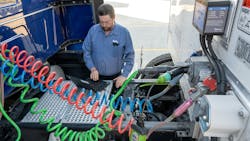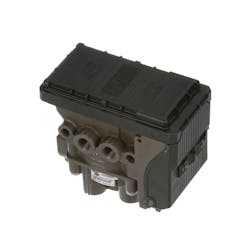Bendix Tech Tips: Selecting the right valve for your trailer application
Key takeaways:
- Spec'ing your trailers with the right valving is critical for ABS and ECU functionality
- When spec'ing valves, consider the length of your trailer, axle spread, vocation, towing vs. non-towing capabilities, and stability systems
- Also be sure to consider whether your braking system will provide connectivity features
Choosing the right ABS (antilock braking system) electronic control unit (ECU) and associated valving for your trailer can make the difference between compliance on paper and reliable performance on the road. Be it a short dry van, a long tanker, or a trailer built to tow, each is required to meet baseline performance requirements for air-braked trailers in the United States and Canada (FMVSS/CMVSS 121). That said, each type of trailer requires a different valve setup to do it right. Matching the package to the trailer’s length, vocation, and specific features is what separates the merely compliant from the truly road ready.
- Stability systems: Trailer roll-stability programs (such as Bendix TABS-6 single-channel and multichannel configurations) require accurate trailer inputs – length, weight, and wheelbase – to tailor software and interventions. Planning stability at the design stage makes sure that sensor and modulator placements, plumbing, and valve selection all work together.
“Trailers with more axles or specialty designs benefit from extra valves and more points of control,” said John Ripley, vehicle systems engineer at Bendix. “Added control helps trailers respond more smoothly in real-world maneuvers and also sets the stage for easier diagnostics, stability features, and the connectivity fleets are looking for.”
Features and connectivity drive choices
Modern trailers often require braking systems that do more than cover the basics. When fleets request features such as lift axles, rear unloading systems, friction and rotor-wear alerts, or low-system-pressure warnings, those needs drive which valves and electronic control units are built into the trailer by manufacturers and their suppliers.
Many fleets are also asking for trailers that share useful data with their service teams. Those expectations shape ECU choice, since the right unit enables contemporary diagnostic functions while also positioning the trailer for future capabilities – like predictive maintenance alerts, tractor-trailer communication, and advanced stability functions.
“Thinking about connectivity up front helps fleets avoid costly retrofits later,” said Humphreys. “Advanced controllers open the door to diagnostics, service tools, and the electronic features that may keep trailers competitive in the years ahead.”
Make it a system
Selecting the right valves, sensors, and controllers is only part of the job. The trailer OE will make sure all the components work together as a complete braking system and put the finished unit through end-of-line tests before it ever leaves the plant.
Over the life of the trailer, keeping diagnostic tools up to date and ensuring technicians are trained on the latest systems helps maintain performance.
“The right valve choices begin with fleets clearly defining their operating needs,” said Ripley. “When fleets, builders, and brake-system suppliers align early at the system level, it’s more likely to result in a trailer that delivers on both compliance and performance.”
Quick spec checklist
Before finalizing your selection, it helps to run through the essentials. These checks guide spec decisions and make sure the design supports both compliance and performance.
- Trailer basics: length, wheelbase, axle count/spread, and towing capability
- Braking setup: ABS/stability system type (single channel vs. multichannel)
- Valve needs: booster or relay valve for longer/towing trailers
- Feature set: lift-axle control, rear unloading, friction and rotor-wear alerts, low-system-pressure warnings all affect the correct ECU selection
- Connectivity: diagnostics/data-sharing for current and future smart-trailer needs (J1939, PLC and ISO 11992, for example)
- Testing: end-of-line checks and documentation (timing, sensor placement, plumbing)

